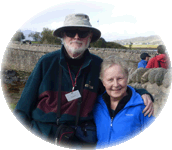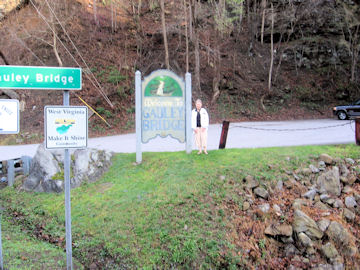
The Keatings Visit Gauly Bridge

Hi Folks,
Liz and I have returned from another trip to North Carolina to see our daughter, son-in-law and grandchildren. On the way down we detoured to Gauley Bridge, West Virginia.
Liz' grandmother grew up in Gauley Bridge and she has always wanted to visit. Liz told me that her grandmother told her stories about a covered bridge in Gauley Bridge burned by Confederate troops in the Civil War. She told Liz that adults would talk about it frequently in the 1890s when she was a little girl.
I did some research and found a picture confirming her grandmother's story. See http://www.lostbridges.org/details.aspx?id=WV/48-10-01_2x&loc=n. Liz was so happy that I found this picture that she had me print it out so she could add it to 1 of her 3 covered bridge albums.
The Keatings on this list may be interested in the "Keating Railroad bridge" in Clinton County, Pa, same website. If you are interested in the history of covered bridges, try reading "Bridging Deep South Rivers The Life and Legend of Horace King" by John S. Lupold & Thomas L. French Jr. There is a sentence on p.261 which I found amusing: "Covered bridge aficionados—a significant subset of antiquarians have continued to praise the architectural and building skills of the Kings because, to repeat the obvious, many of their spans survived." John S. Lupold is identified as a history professor at Columbus State University and Thomas L. French Jr is identified as an architect, surveyor and the foremost authority on Georgia's covered bridges. Perhaps a bit of inside humor? This part of the book was the conclusion, discussing why Horace King remains in historical terms the best known builder and one the most recognized African Americans in the lower Chattahoochee Valley.
There are a large number of pictures of lost covered bridges in this book—some not found on the above website. An unlikely group of people has identified with Horace King: African Americans, covered bridgers and neo Confederates who hold Horace up as proof that slavery was a benevolent institution. Horace was born a slave in 1807, in Cheraw,SC. He was of mixed race descent—Cherokee, white and black. He purchased his freedom in 1846. He had established such a fine reputation as a builder of covered bridges, warehouses, etc, that a bill was passed that year by the Alabama legislature confirming his status as a free man. Evidently re-enslavement was not uncommon. His owner, John Godwin, builder of covered bridges, had taught him the craft of building covered bridges. Godwin allowed him to marry a free mixed race woman in 1839 and waived his right to enslave Horace's children.
Godwin died in 1859. In 1860, Horace paid $250 to have a large monument erected at his grave(still the largest in the cemetery). Neo Confederates cite these facts as evidence of the benevolence of slavery. The authors point out that in 1860 the Alabama legislature very nearly passed a bill that would have re-enslaved all free blacks or forced them to leave the state. It failed by 3 votes. Arkansas actually did pass such a law. This was a reaction to the Harper's Ferry raid—5 free black men were part of John Brown's crew. Most free blacks demonstrated that they were not revolutionaries by owning slaves. Horace refused to do this. The authors believe the monument was Horace's way of showing that he was not a revolutionary, but a "safe black man."
One final thing that struck me. Horace was not allowed to enter into a contract on his own, even though he was a free man after 1846. He had to have a white man sign the contract as guardian for him. This was the law in all southern states. The authors believe that the Red Oak Creek bridge in Meriwether County, Ga., attributed to Horace King and built in the 1840s, was actually built in the 1860s and might have built by Horace or one of his sons. Three bridges built by Washington King, son of Horace, have survived: Stone Mtn Park, Euharlee and Watson Mill. Another son, George, built a bridge now in Callaway Gardens.
To see pictures of these bridges, see http://www.dot.ga.gov/travelingingeorgia/coveredbridges/Pages/HistoryofCoveredBridges.aspx. This website also has directions and maps.
For a more personal tour, see http://www.vermontbridges.com/travel%20keatings.htm.
Tom

Photo by Tom Keating
May 2010
